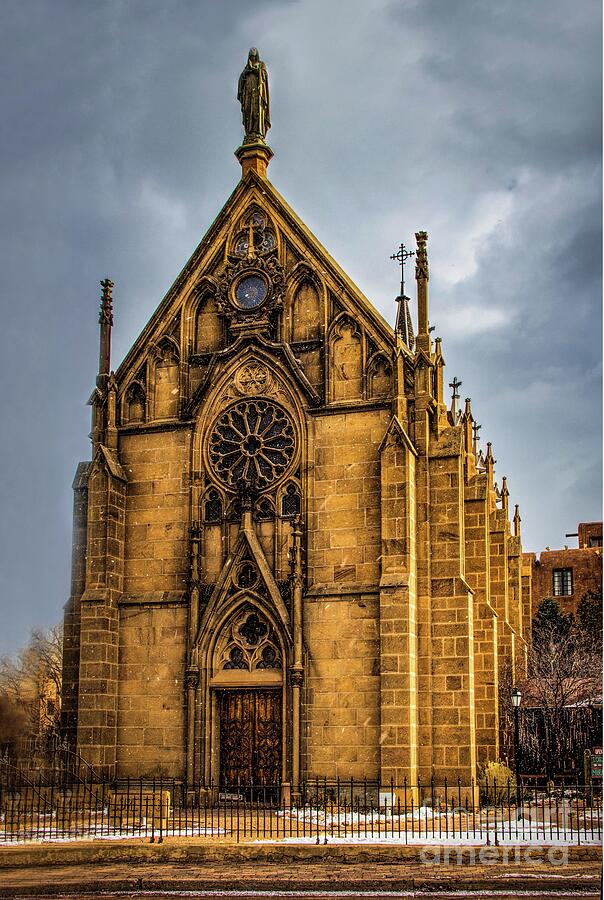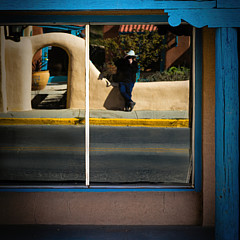
Loretto Chapel

by Jon Burch Photography
Title
Loretto Chapel
Artist
Jon Burch Photography
Medium
Photograph - Digital Capture/faa Watermark Will Not Appear On Your Finished Photograph.
Description
The Loretto Chapel in Santa Fe, New Mexico, is a former Roman Catholic church that is now used as a museum and wedding chapel. The church is known for its unusual helix-shaped spiral staircase known as the "Miraculous Stair", the name and origin of the builder has still not been verified. It has been the subject of legend and rumor, and the circumstances surrounding its construction and its builder are considered miraculous by the Sisters of Loretto who credit St. Joseph with its construction.
In 1872 Jean-Baptiste Lamy, the Bishop of the Santa Fe Archdiocese, commissioned the building of a convent chapel to be named Our Lady of Light Chapel, which would be in the care of the Sisters of Loretto. The chapel was designed by French architect Antoine Mouly in the Gothic Revival style, complete with spires, buttresses, and stained glass windows imported from France. Although it was built on a much smaller scale, the chapel bears an obvious resemblance to the Sainte-Chapelle in Paris.
The architect died suddenly and it was only after much of the chapel was constructed that the builders realized it was lacking any type of stairway to the choir loft but due to the chapel's small size, a standard staircase would have been too large. Historians have also noted that earlier churches of the period had ladders rather than stairs to the choir loft, but the Sisters did not feel comfortable with that prospect because of the long habits that they wore.
Needing a way to get up to the choir loft the nuns prayed for St. Joseph's intercession for nine straight days. On the day after their novena ended a shabby-looking stranger appeared at their door. The stranger told the nuns he would build them a staircase but that he needed total privacy and locked himself in the chapel for three months. He used a small number of primitive tools including a square, a saw and some warm water and constructed a spiral staircase entirely of non-native wood. The identity of the carpenter is not known for as soon as the staircase was finally finished he was gone. Many witnesses, upon seeing the staircase, feel it was constructed by St. Joseph himself, as a miraculous occurrence.
The resulting staircase is an impressive work of carpentry. Ascending twenty feet, it making two complete revolutions up to the choir loft without the use of nails or apparent center support. It has been surmised that the central spiral of the staircase is narrow enough to serve as a central beam. Nonetheless there was no attachment unto any wall or pole in the original stairway, although in 1887 a railing was added and the outer spiral was fastened to an adjacent pillar. Instead of metal nails, the staircase was constructed using dowels or wooden pegs.
The staircase has 33 steps, the same age of Jesus Christ, with risers all same height. Made of an apparently extinct wood species, it was constructed with only square wooden pegs without glue or nails making over two complete 360-degree turns and standing 20 feet tall with no center support.
The legend claims that the mystery had never been satisfactorily solved as to who the carpenter was or where he got his lumber, and that there were no reports of anyone seeing lumber delivered or even seeing the man come and go while the construction was being done. Since he left before the Mother Superior could pay him, the Sisters of Loretto offered a reward for the identity of the man, but it was never claimed.
Image copyright 2015 Jon Burch Photography
Uploaded
April 2nd, 2015
Statistics
Viewed 247 Times - Last Visitor from New York, NY on 04/21/2024 at 8:41 AM
Embed
Share
Sales Sheet
Comments (4)

Steven Bateson
The New Mexico Land of Enchantment Group is honored that you chose to submit your work to the group and we are proud to feature your magnificent image on the Homepage in the Featured Images.






































